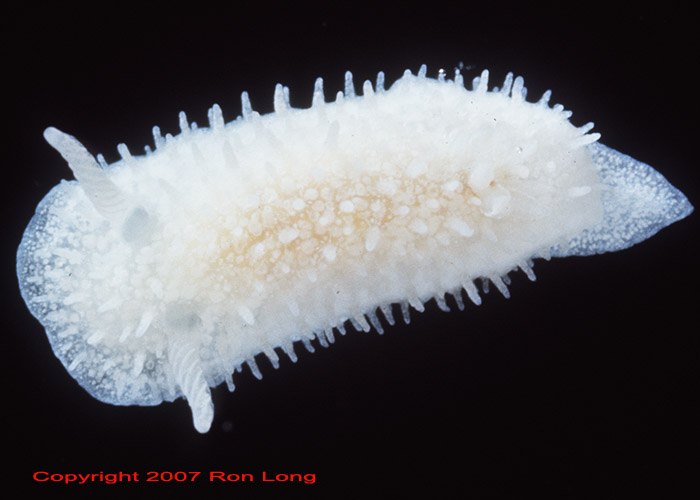 |
Diaphorodoris lirulatocauda
Photo courtesy of Ron Long
Victoria, British Columbia, Canada
Diaphorodoris lirulatocauda, Millen, 1985
This is yet another of the small, white, tuberculose dorids belonging to the family Onchidorididae , which occurs in northeastern Pacific waters. When I started to sort them out, I had two broad categories, oval and elongate oval with trailing tails. The oval category contains Onchidoris muricata (BOW#552) , Adalaria proxima (BOW#222) and Adalaria jannae (BOW#220). More elongate than these three species, with a longer ‘tail’ are Diaphorodoris lirulatocauda , whose name means ridged tail, Akiodoris salacia and Adalaria evincta. Of these three, Diaphorodoris is the most common and has the widest known range, extending from Ketchikan, Alaska to Baja California, Mexico. This species reaches a size of 12 mm and is wider in front than behind. Posteriorly, the trailing portion of the foot comes to a sharp point and has a medial ridge. The tubercles and long and slender, without protruding spicules, giving the animal a fuzzy appearance. Rhinophores have 6-10 sloping lamellae and their sheaths have three tubercles. The 4-9 gills are simple and joined at their bases, not containing notum or tubercles. The radula has 29-33 rows of teeth with no central tooth, one large triangular lateral tooth, with a bent hook and 11-13 denticles and two marginal teeth; the outermost of which is vestigial.
This species is usually found under rocks or on rock surfaces eating colonial bryozoans. They are found year round, but attain their largest size in the summer, spawning in June, July and September. It lays a white spawn mass with a sausage shaped coil of 1-4 turns and details of development can be found in Goddard (1984).
References:
Goddard, J. 1984. The opisthobranchs of Cape Arago, Oregon, with notes on their biology and a summary of benthic opisthobranchs known from Oregon. Veliger 27(2): 143-163.
Millen, Sandra V. 1985. The nudibranch genera Onchidoris and Diaphorodoris (Mollusca, Opisthobranchia) in the northeastern Pacific. Veliger 28(1): 80-93.
Photos –Ron Long is a retired biological photographer from Simon Fraser University. Ron is a close up specialist who has taken many excellent Opisthobranch photos. In his retirement he gives talks and leads photographic wildflower trips to interesting places as far apart as Pink Mountain, B.C., and South Africa. Ron can be reached at rlphoto@shaw.ca. Diaphorodoris photo: tank shot with a Pentax and macro lens. Scanning Electron Microphotograph of radula taken by Sandra Millen.
Send Ron email at rlphoto@shaw.ca
Taxonomy -Sandra Millen is a marine biologist who teaches at the University of British Columbia, Vancouver, Canada. She has described eighteen new species of nudibranchs and is currently working on several more. A list of her publications can be seen at her website and she can be contacted by e-mail at millen@zoology.ubc.ca.
Send Sandra email at millen@zoology.ubc.ca
Webmaster
Nov., 2007
